 Photo ©
Keith Williams
Photo ©
Keith Williams
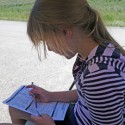
A Lesson Learned is a Lesson Earned
It’s back-to-school time, NestWatchers! We thought this would be a great time to welcome you back to NestWatch if you haven’t been online this summer, encourage you to get those data sheets out, and log on. We learned a few lessons this month about common data entry mistakes people make, and we wanted to share them with you to help make the process easier. So, have a seat, get out your pencil, and take a note:
- One common mistake is not ending the nest attempt at the appropriate time. You should create a new nest attempt each time a pair begins a new clutch. Once the nest fledges or fails, you should end the attempt by entering the summary information, and clicking “End This Attempt.” Once you have done this, you will again have the option to “Add an Attempt”, which will allow you to create additional attempts for subsequent nestings. Please do not record multiple consecutive nestings under the same attempt, or your number of nest attempts will be under-counted. Remember, the unit that we study is the individual nest attempt (eggs to fledglings), not the box or nest site itself.
- Another common mistake that people make is forgetting to declare a “Nest Fate” when summarizing an attempt. When you’re finished summarizing your attempt, you are required to select a nest fate so that we can categorize this attempt as successful, failed, or unknown. Last year, 14% of nest attempts had no fate declared, or had a fate that did not match the nest visits. Without this piece of information, your data may not be usable for many kinds of important analyses. Be sure to check that your entries match the outcome you selected.
- Don’t forget to set the species for each nest attempt. The main reason that a Species Summary Download doesn’t match the Quick Summary is that the Quick Summary counts unidentified species, but the Species Summary Download does not. If some eggs or nestlings seem to have “gone missing” when you review your spreadsheet, check first for unnamed species. Without a species name, all of your hard work might be impossible to interpret.
Your homework for this month is to check out our list of how-to videos that we created especially for you. They cover a range of helpful topics and will walk you through the entire process step-by-step. If you still have any questions about how to enter your data, please feel free to ask us. Keep up the great work, NestWatchers! In our opinion, you all deserve a gold star.
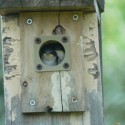
To Paint, or Not to Paint?
NestWatchers often ask if it is safe to use paint or stain to preserve a nest box, so we recently published a new FAQ article about this at NestWatch.org. The controversy lies in the fact that there are no conclusive studies that determine whether residual fumes from paint, stains, or pressure treatment can harm the birds. Some builders argue that it takes longer to paint a box than it does to build a new one, and that paint must be reapplied every few years to be effective. Others point out that trees can be spared if nest boxes are made to last longer. And there are many who claim that the risk from birds overheating in an unpainted box is greater than the risk of toxic fumes.
Without peer-reviewed studies on this topic to guide us, we recommend using untreated, unpainted wood to construct boxes because it most closely resembles what the birds would have used before the advent of nest boxes. A well-constructed house should last 10–15 years on its own (cedar, spruce, white pine, and yellow pine are good rot-resistant choices for lumber). Pressure-treated wood has been saturated with a combination of pesticide and fungicide, and therefore, should be avoided as nest box material. Alternatively, you can extend the life of your nest box by gluing all the seams of the non-opening sides before nailing them. Recess the floor about ¼″ to reduce deterioration from moisture. Use only durable materials, especially for the roof, which deteriorates faster than the other panels. You can further protect the box by placing the roof panel such that the growth rings bend down in a “frown” rather than up in a “smile.” When the roof begins to warp in the direction of its growth rings (as all solid lumber will do), then it will warp downward and still protect the box from rain. Angled roofs will last longer than flat roofs, but flat-roofed boxes can be mounted at a slight downward angle to shed rain.
We do recognize that in hot climates, where daytime temperatures regularly exceed 95°F, some nest box monitors choose to paint the exterior of boxes so that they stay cooler. Proper ventilation and a roof that extends two inches over the sides will help shade the box and protect it from the elements, reducing the need for paint. However, some additional cooling may be gained by painting the roof and exterior walls a light color (white is preferred for Purple Martin houses, but opt for tan, gray, or dull green for other cavity-nesting species as these are less conspicuous to predators). If paint is deemed necessary by the monitor, then it should only be applied to the exterior, never the inside. Even zero- and low-emissions latex paint formulas or oil-based stains can release fumes for months, so if you paint, plan to do so in the fall, which will give fumes time to dissipate throughout the winter as the paint cures.
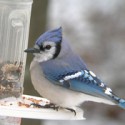
Count Feeder Birds for Science
Help the Cornell Lab of Ornithology learn about the habits of backyard birds by participating in Project FeederWatch. Anyone with an interest in birds and nature can participate in the project. The information you and others report online helps scientists at the Cornell Lab track changes in the numbers and distribution of birds across the continent.
“By watching and keeping track of the birds in your own neighborhood, you really can make a difference,” says project leader David Bonter. “The more people watching, the more we can learn about the birds that brighten the winter landscape.”
More than 50,000 people have participated in FeederWatch, and new participants are welcome to join at any time. The 27th season of Project FeederWatch begins November 9. Join today and receive your kit before the new season begins.

In Defense of the Nest
Chapter Coordinator Kathleen Dougherty (Oakland County Parks & Recreation, Waterford, Michigan) shared with us the harrowing story about what happens when you threaten a mother Osprey’s nest. A Great Blue Heron that tried to perch on an Osprey nest in Kensington Metropark was soundly rebuked by the resident Osprey. Almost all birds will defend their nest from predators; however, Ospreys must additionally defend their nest site from non-migratory species that nest earlier, like the Great Blue Heron, that could potentially take over their nest site before the Ospreys return in the spring.
We also know that sometimes the situation is reversed, and Ospreys can challenge herons on their nests in turn. Usually, it does not end fatally for either species. In this instance, the heron made a full recovery and went back to its own roost site. We can’t say for sure whether the human witnesses are fully recovered from their shock yet.
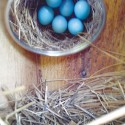
NestWatcher in the News
Three cheers for NestWatcher Jim Bearden who recently made headlines by creating a bluebird nesting trail in Powder Springs, Georgia. Jim began creating the 2.3 miles of bluebird nesting habitat, complete with 25 nest boxes and multiple feeding stations, in his neighborhood’s community garden in April 2012. In this first full nesting season, the trail has already hosted 111 fledglings, including Eastern Bluebird, Carolina Chickadee, and Carolina Wren!
For inspiration on starting your own bluebird trail, and for updates on Jim’s progress, follow along on the Green Meadows Preserve Bluebird Trail blog. Congratulations, Jim, on recruiting your first tenants, and we wish you many years of success to come.
Share Your News
Do YOU have a newsworthy nest story to share with the NestWatch community? We’d love to know about it. Please email us the details, and we’ll do our best to spread the word.
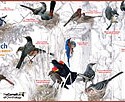
Monthly Winner
At the beginning of each month, NestWatch randomly selects one participant who has entered data that month to receive a copy of the NestWatch Common Nesting Birds of North America poster. This month’s lucky winner is Larry Hopwood. Congratulations, Larry!